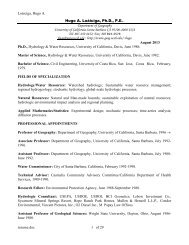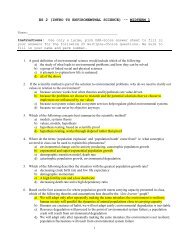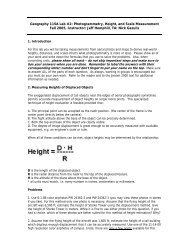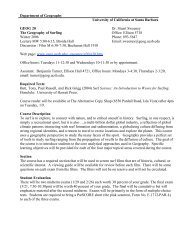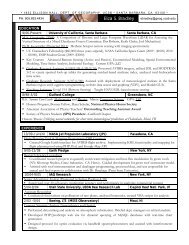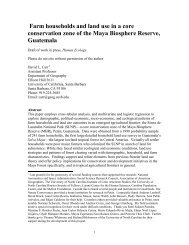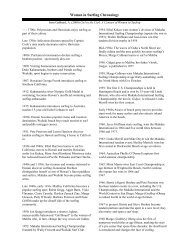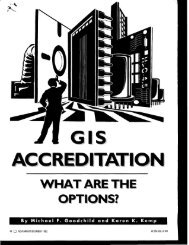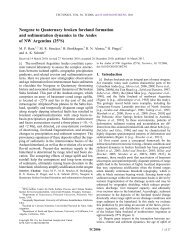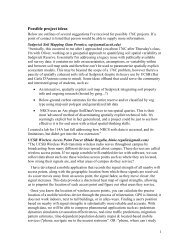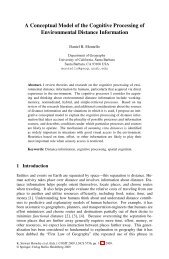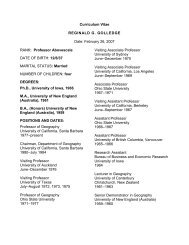Spatial knowledge acquisition from direct experience in the ...
Spatial knowledge acquisition from direct experience in the ...
Spatial knowledge acquisition from direct experience in the ...
Create successful ePaper yourself
Turn your PDF publications into a flip-book with our unique Google optimized e-Paper software.
118 T. Ishikawa, D.R. Montello / Cognitive Psychology 52 (2006) 93–129<br />
4.3.4. Two models for <strong>the</strong> <strong>in</strong>tegrated routes<br />
Sketch mapp<strong>in</strong>g of <strong>the</strong> two <strong>in</strong>tegrated routes drawn toge<strong>the</strong>r <strong>in</strong> Session 4 (after Wrst travel<strong>in</strong>g<br />
<strong>the</strong> connect<strong>in</strong>g-route) was simulated by two models: a random 12 model and a random LR<br />
model. The Wrst model generated 12 po<strong>in</strong>ts randomly with<strong>in</strong> <strong>the</strong> space of <strong>the</strong> map draw<strong>in</strong>g.<br />
The second model generated six po<strong>in</strong>ts randomly on <strong>the</strong> right half, and ano<strong>the</strong>r six po<strong>in</strong>ts<br />
randomly on <strong>the</strong> left half. Simulated performance by <strong>the</strong> two models was quite a bit worse<br />
than performance by participants, z’s D¡28.74 and ¡17.68, respectively, p’s < .001.<br />
5. Discussion<br />
Detailed analyses of <strong>the</strong> rich empirical data <strong>from</strong> <strong>the</strong> present study reveal various<br />
aspects of people’s spatial <strong>knowledge</strong> acquired <strong>direct</strong>ly <strong>in</strong> a large-scale environment. In<br />
short, <strong>the</strong> process of spatial <strong>knowledge</strong> <strong>acquisition</strong> does not proceed <strong>in</strong> <strong>the</strong> way posited by<br />
Siegel and White’s (1975) framework. This dom<strong>in</strong>ant framework does <strong>in</strong>sightfully specify<br />
types of <strong>knowledge</strong> that people may have about spatial environments: <strong>knowledge</strong> of landmarks,<br />
<strong>knowledge</strong> of routes, and <strong>knowledge</strong> of conWgurations. What is questionable about<br />
<strong>the</strong> framework is not so much <strong>the</strong> content, but <strong>the</strong> structure and developmental course of<br />
spatial <strong>knowledge</strong> it proposes. Also, nei<strong>the</strong>r <strong>the</strong> dom<strong>in</strong>ant nor <strong>the</strong> cont<strong>in</strong>uous framework<br />
adequately takes <strong>in</strong>to account <strong>the</strong> large <strong>in</strong>dividual diVerences among people <strong>in</strong> <strong>the</strong>ir accuracy<br />
and developmental pattern of spatial <strong>knowledge</strong>. We consider <strong>the</strong> implications of our<br />
results for <strong>the</strong>ories of <strong>the</strong> microgenesis of spatial <strong>knowledge</strong> <strong>in</strong> environments.<br />
5.1. Acquisition of metric spatial <strong>knowledge</strong> with<strong>in</strong> <strong>the</strong> separate routes<br />
5.1.1. First exposure<br />
Participants’ perfect performance on nam<strong>in</strong>g landmarks <strong>in</strong> order of appearance shows that<br />
<strong>the</strong>y acquired m<strong>in</strong>imal “landmark <strong>knowledge</strong>” and “route <strong>knowledge</strong>” (i.e., <strong>the</strong> identities and<br />
sequence of landmarks) right away, upon Wrst exposure to a complex new environment. This<br />
empirical Wnd<strong>in</strong>g is evidence aga<strong>in</strong>st <strong>the</strong> dom<strong>in</strong>ant framework’s separation of <strong>the</strong> <strong>acquisition</strong> of<br />
landmark <strong>knowledge</strong> <strong>from</strong> route <strong>knowledge</strong>, putt<strong>in</strong>g <strong>the</strong> former before <strong>the</strong> latter <strong>in</strong> a sequence.<br />
Instead, <strong>the</strong> two types of <strong>knowledge</strong> are acquired at <strong>the</strong> same time, more or less immediately.<br />
As discussed <strong>in</strong> Section 1, <strong>the</strong> dom<strong>in</strong>ant framework uses <strong>the</strong> term route to mean a<br />
sequence of landmarks, <strong>the</strong> space between <strong>the</strong> landmarks be<strong>in</strong>g relatively empty or<br />
unscaled (Siegel & White, 1975, p. 29). That is, at least at an early stage of exploration <strong>in</strong> a<br />
new environment, <strong>the</strong> dom<strong>in</strong>ant framework argues that people have no metric <strong>knowledge</strong>,<br />
only connectivity and sequence <strong>knowledge</strong>. On <strong>the</strong> contrary, our results <strong>in</strong>dicate that participants<br />
quickly acquire some metric <strong>knowledge</strong> of environmental layout, as evidenced by<br />
<strong>the</strong> fact that <strong>the</strong>y estimate <strong>direct</strong>ions and distances, and draw sketch maps, more accurately<br />
after Wrst exposure to <strong>the</strong> routes than would be expected by pure chance alone.<br />
5.1.2. F<strong>in</strong>al exposure and developmental trends<br />
Turn<strong>in</strong>g now to performance after <strong>the</strong> Wnal of <strong>the</strong> 10 sessions, we Wnd that participants<br />
on average show surpris<strong>in</strong>gly little improvement <strong>in</strong> performance beyond that<br />
found after <strong>the</strong> Wrst session. Changes <strong>in</strong> <strong>direct</strong>ion estimates on <strong>the</strong> U-route do show signiWcant<br />
l<strong>in</strong>ear and cubic trends across <strong>the</strong> 10 sessions, though <strong>the</strong> total variation <strong>in</strong> mean<br />
performance is only about 10° across <strong>the</strong> sessions. Changes on <strong>the</strong> S-route do not reveal<br />
any signiWcant trends.



